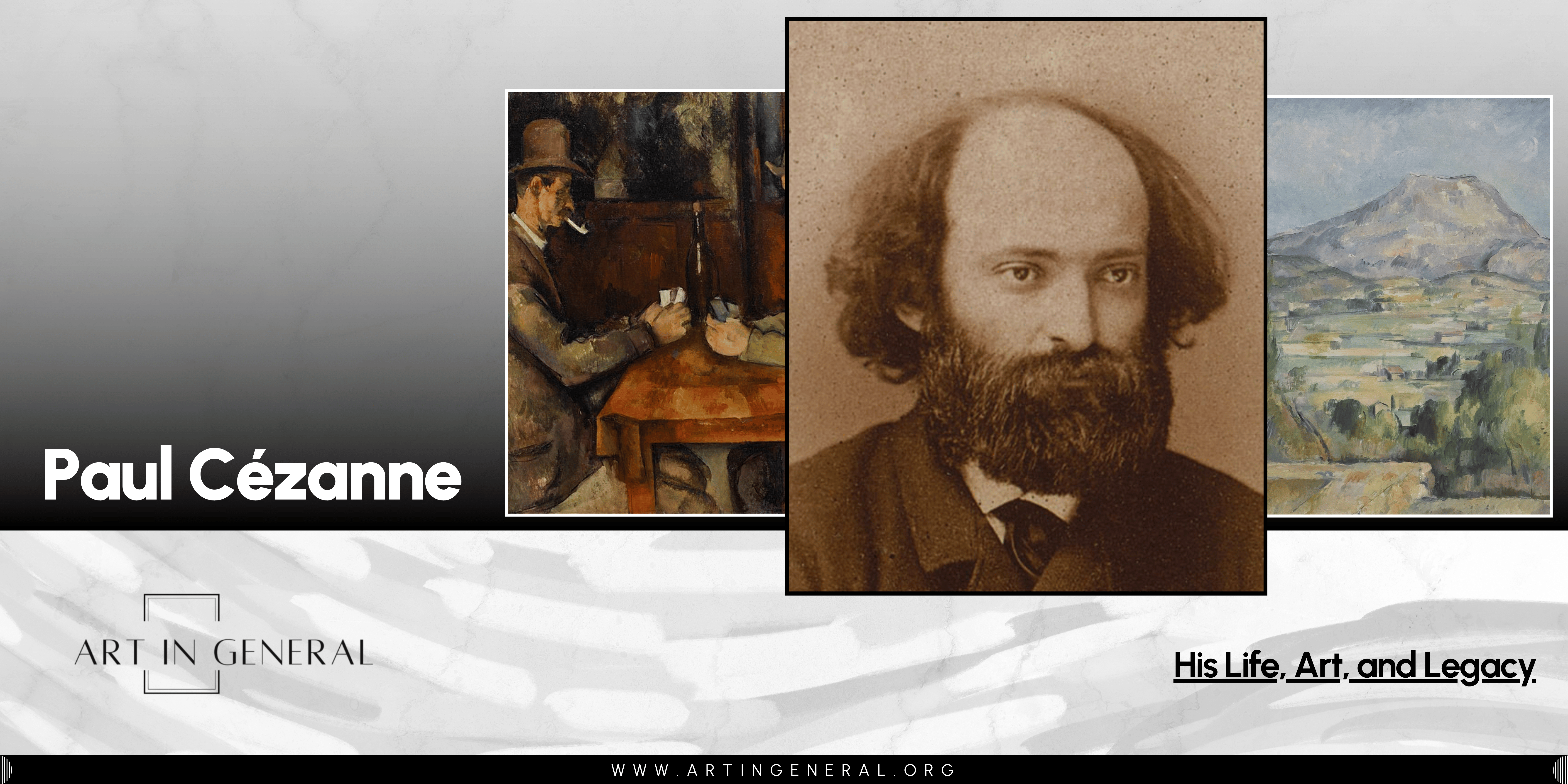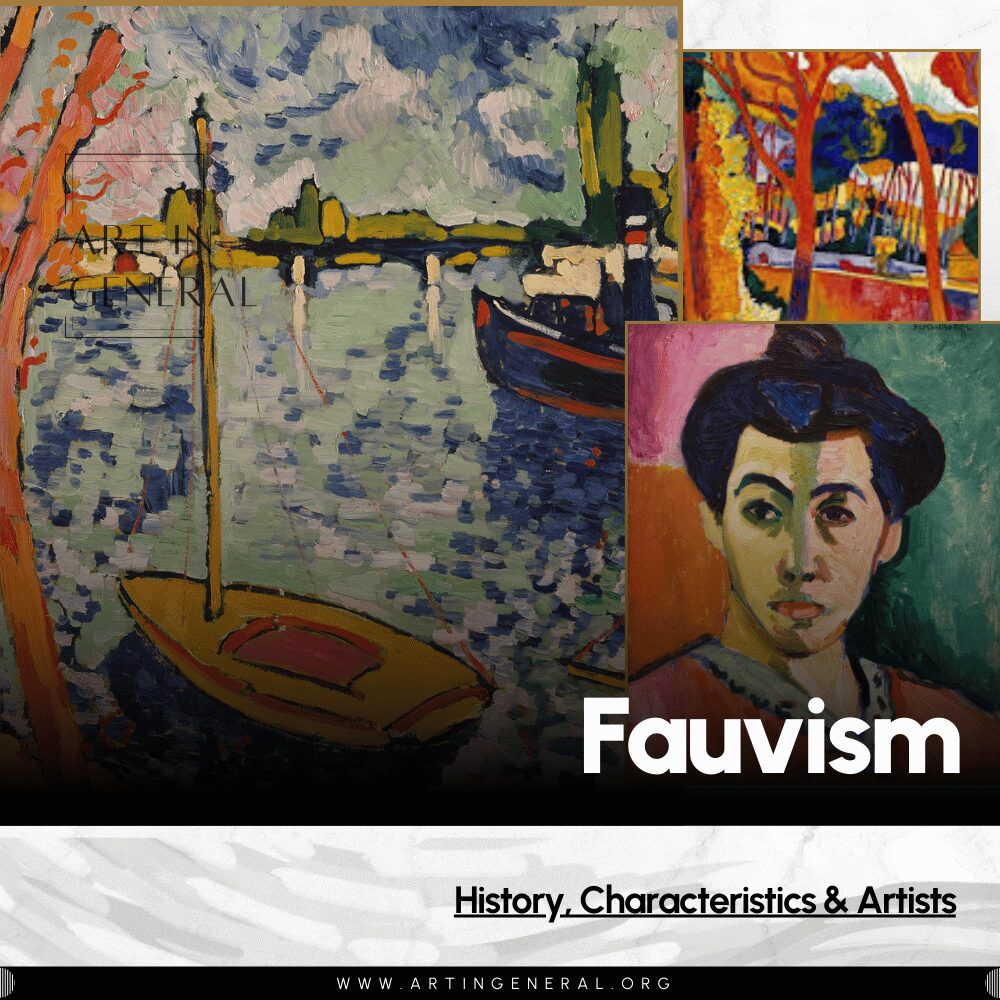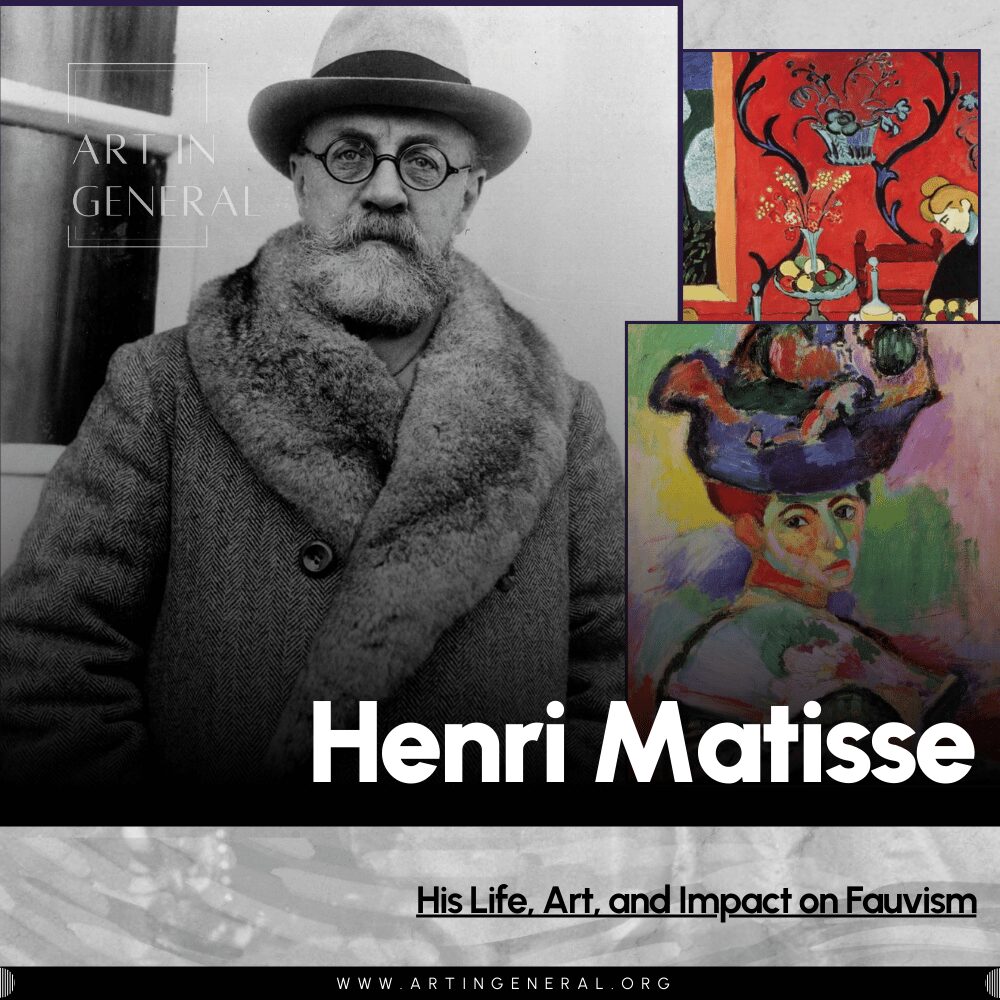Who Was Paul Cézanne?

Paul Cézanne (1839–1906) was a French painter whose work laid the foundation for the transition from 19th-century Impressionism to 20th-century Cubism. Widely regarded as one of the most influential artists in the history of modern art, Cézanne’s unique approach to form, color, and composition helped shape the development of modern art movements like Fauvism and Cubism. Known for his landscapes, still lifes, and portraits, Cézanne’s work was revolutionary in its breaking away from traditional artistic conventions, focusing on the structure and geometry beneath natural forms. His influence on the next generation of artists, including Picasso and Matisse, cannot be overstated.
Early Life and Education
Paul Cézanne was born on January 19, 1839, in Aix-en-Provence, France, into a wealthy banking family. His father, Louis-Auguste Cézanne, was a successful banker, which provided Paul with financial security throughout his life, even though he often clashed with his father over his decision to pursue a career in art rather than follow in the family business. Cézanne’s mother, Anne-Elisabeth Honorine Aubert, was a more sensitive and supportive figure in his life, fostering his love for the arts.
Cézanne showed an early interest in painting and drawing, but his father initially insisted that he study law. In 1859, Cézanne enrolled at the University of Aix to study law, but his passion for art could not be suppressed. In 1861, against his father’s wishes, Cézanne left law school and moved to Paris to pursue his artistic career. There, he enrolled in the Académie Suisse, a free art school, where he met other young artists, including Camille Pissarro, who would become a lifelong friend and mentor.
What Did Paul Cézanne Paint About?
Cézanne’s work was largely focused on three central themes: landscapes, still lifes, and portraits. Unlike the Impressionists, who were his contemporaries, Cézanne was not solely interested in capturing the fleeting effects of light. Instead, he sought to reveal the underlying structures of nature, emphasizing form and volume in his depictions of natural subjects. Cézanne’s landscapes, particularly his views of Mont Sainte-Victoire, showcase his deep connection to the natural world, as well as his innovative approach to color and form.
In his still lifes, Cézanne often used everyday objects like fruit, bottles, and ceramics, but he imbued them with a sense of weight and permanence. His careful study of these objects allowed him to experiment with perspective and depth, creating compositions that were both dynamic and stable. Cézanne’s portraits, though less numerous than his still lifes and landscapes, reveal his interest in capturing the emotional depth of his subjects while maintaining a strong sense of structure.
Artistic Development and the Early Years in Paris
Paul Cézanne’s move to Paris in 1861 marked the beginning of his serious artistic journey, but it was not without its challenges. Paris, at the time, was the center of the art world, and while Cézanne was passionate about painting, his early works were often met with criticism and rejection. The Paris Salon, the official art exhibition of the Académie des Beaux-Arts, rejected his submissions repeatedly, leaving Cézanne frustrated and on the periphery of the art establishment.
However, Cézanne was undeterred. During these early years, he developed close friendships with many key figures in the art world, including Édouard Manet and Gustave Courbet. His greatest influence during this period was Camille Pissarro, an older and more established painter who was part of the emerging Impressionist movement. Pissarro’s approach to landscape painting, particularly his emphasis on painting en plein air (outdoors), inspired Cézanne to explore the natural world more deeply.
Cézanne’s Association with the Impressionists
Though Cézanne never fully aligned himself with the Impressionists, he participated in their first and third exhibitions in 1874 and 1877, respectively. The Impressionists, including artists like Claude Monet, Edgar Degas, and Pierre-Auguste Renoir, sought to break away from the rigid conventions of academic painting. They focused on capturing the effects of light and color, often painting everyday scenes and landscapes.
Cézanne’s contributions to these exhibitions were met with mixed reviews. His paintings were considered too rough, unpolished, and unconventional by many critics. While the Impressionists emphasized the fleeting nature of light and atmosphere, Cézanne’s focus was on structure and form, which set him apart from his peers. His work was often described as heavy-handed, but his commitment to his own vision remained unwavering.
During this period, Cézanne began experimenting with color in new ways. Instead of using shading to create depth, he applied color in patches, allowing each color to stand on its own while contributing to the overall structure of the painting. This technique would later become one of Cézanne’s signature methods, influencing the development of modern art movements like Fauvism and Cubism.
Cézanne’s Shift Towards Post-Impressionism
By the late 1870s, Cézanne had distanced himself from the Impressionists, feeling that their focus on the transitory effects of light was insufficient to express the deeper truths he sought to convey in his work. He turned towards a more methodical and structured approach, which would later be recognized as Post-Impressionism. Post-Impressionism was not a cohesive movement, but it encompassed artists like Cézanne, Vincent van Gogh, and Georges Seurat, who sought to extend and challenge the boundaries of Impressionism.
For Cézanne, this period marked a turning point in his artistic career. He began to emphasize the geometric underpinnings of the natural world, reducing objects in his paintings to their fundamental shapes—cylinders, spheres, and cones. This exploration of form and structure would lay the groundwork for the development of Cubism, influencing artists like Pablo Picasso and Georges Braque.
Iconic Works and Techniques
Paul Cézanne is best known for his groundbreaking exploration of form, color, and structure, which became hallmarks of his mature work. His artistic techniques and iconic pieces not only marked the transition from Impressionism to Post-Impressionism but also influenced a wide array of modern art movements. Some of his most famous works demonstrate his innovative use of color, perspective, and geometric shapes, elements that would later inspire Cubism.
Mont Sainte-Victoire Series (1882 and 1906)

One of Cézanne’s most iconic subjects is Mont Sainte-Victoire, a mountain near his hometown of Aix-en-Provence. Cézanne painted this mountain more than 30 times, with each version showcasing different perspectives, colors, and moods. Through these series, he became increasingly concerned with capturing the underlying structure of nature, reducing the landscape into planes and simplified shapes.
- Technique: In the Mont Sainte-Victoire paintings, Cézanne’s technique of applying patches of color is evident. He used brushstrokes in varying directions to create texture and depth. The mountain and the surrounding landscape are reduced to geometric forms—cylinders, cones, and blocks—creating a sense of stability and permanence. Cézanne’s choice to paint the same scene repeatedly also shows his dedication to understanding how color and form interact with one another over time and under different conditions.
The Card Players (1890-1895)

Another significant work from Cézanne’s mature period is “The Card Players,” a series of five paintings that depict Provencal peasants quietly playing cards. The figures in these paintings are monumental and stoic, rooted firmly in their environment, with little interaction beyond the game.
- Technique: Cézanne’s use of solid, bold shapes in these works emphasizes his shift away from the fluid, light-driven approach of the Impressionists. The figures are almost sculptural in their form, painted with a simplicity and solidity that conveys their connection to the earth. The muted color palette and careful attention to the geometry of the figures and space around them highlight Cézanne’s commitment to creating a structured composition.
Still Life with Apples (1890s)

Cézanne’s still lifes, particularly “Still Life with Apples,” are another key example of his innovative approach to painting. Rather than creating a realistic depiction of the objects, Cézanne focused on their shape and form, rearranging them to create a more dynamic composition.
- Technique: In this still life, Cézanne used color not only to define the objects but also to create a sense of depth and volume. His trademark technique of applying color in flat, broad patches is evident here, making the apples and table appear more like abstract forms than realistic objects. This exploration of form and spatial relationships in his still lifes paved the way for future artists, particularly those in the Cubist movement.
Innovative Techniques
- Color Patches: Cézanne often used patches of color instead of traditional shading to create volume and depth. This technique, called “constructive brushstroke,” allowed him to give form to objects without relying on chiaroscuro (light and dark contrast).
- Multiple Perspectives: Unlike traditional Western art, which emphasized a single point of view, Cézanne experimented with multiple perspectives within the same painting. For example, in his still lifes, objects often seem to be viewed from different angles at once. This technique later influenced artists like Picasso and Braque in their development of Cubism.
- Form Over Light: While his Impressionist peers were captivated by the effects of light, Cézanne focused more on the structural and geometric forms beneath what he painted. He sought to depict the underlying architecture of nature, reducing landscapes and objects into basic shapes like cones, spheres, and cylinders. This abstraction of form became a key influence in the evolution of modern art.
Influence on Modern Art
Paul Cézanne’s groundbreaking approach to form, structure, and color made him one of the most influential artists in the history of modern art. His work marked a radical departure from the traditional methods of painting, setting the stage for movements such as Cubism, Fauvism, and even Abstract Expressionism. While Cézanne faced criticism during his lifetime, his techniques and artistic philosophy later inspired a generation of artists who reshaped the landscape of modern art.
Cubism and Cézanne’s Geometric Influence
Perhaps the most direct influence of Cézanne’s work can be seen in the development of Cubism. Artists like Pablo Picasso and Georges Braque were deeply influenced by Cézanne’s approach to depicting nature through geometric shapes and multiple perspectives. In his famous advice, Cézanne once stated, “Treat nature by the cylinder, the sphere, the cone,” which became a guiding principle for Cubism.
- Picasso: Picasso openly acknowledged Cézanne’s impact, describing him as “the father of us all.” Picasso’s early Cubist works, like “Les Demoiselles d’Avignon” (1907), show a clear debt to Cézanne’s deconstruction of form and space. The faceted planes and multiple viewpoints seen in Cubist painting are a continuation of Cézanne’s explorations into how objects can be seen from more than one angle at once.
- Braque: Braque, another key figure in the Cubist movement, similarly admired Cézanne’s method of reducing natural forms to their essential geometric shapes. In Braque’s landscapes and still lifes, the influence of Cézanne is evident in the way space and form are fragmented and reassembled, creating compositions that challenge traditional perspective.
Fauvism and Cézanne’s Use of Color
While Cézanne is often associated with form and structure, his exploration of color also had a lasting influence on the Fauvist movement. The Fauves, including artists like Henri Matisse and André Derain, were inspired by Cézanne’s use of bold, unblended color to create depth and volume in his paintings.
- Matisse: Matisse, in particular, was drawn to Cézanne’s use of color to construct form, rather than relying on shading and gradation. In his own work, Matisse applied patches of vibrant color in a way that echoed Cézanne’s technique, but with an even greater emphasis on emotional expression through color.
- Derain: Similarly, André Derain’s landscapes reflect Cézanne’s influence in their bold color choices and simplified shapes. The Fauves took Cézanne’s color theories further, embracing a style that was more expressive and abstract, yet rooted in Cézanne’s methods.
Abstract Expressionism and Cézanne’s Legacy
Though Cézanne passed away in 1906, his impact reached far into the 20th century, influencing not only the early modernists but also movements like Abstract Expressionism. Artists such as Jackson Pollock and Mark Rothko admired Cézanne’s ability to convey emotion and structure simultaneously.
- Pollock: While Pollock’s work may seem distant from Cézanne’s, the American painter’s focus on form and process shares a philosophical link with Cézanne’s methodical approach to building a composition. Both artists viewed painting as a way to represent deeper truths about the world, beyond simple visual appearances.
- Rothko: Rothko, known for his abstract fields of color, was inspired by Cézanne’s exploration of how color could evoke emotion and structure a painting. Rothko once remarked on how Cézanne’s work allowed for a deeper, more meditative experience of art, a concept central to Rothko’s own large-scale, color-saturated canvases.
The Avant-Garde and Cézanne’s Role
Cézanne’s influence went beyond individual artists; he helped shape the entire avant-garde movement of the early 20th century. By breaking away from the traditional, representational art of his time and exploring new ways of seeing and depicting the world, Cézanne paved the way for the more radical artistic experiments that followed.
Many art historians credit Cézanne with being a pivotal figure in the transition from 19th-century Impressionism to 20th-century modernism. His work laid the foundation for the abstraction and deconstruction that would define much of the century’s most influential art movements. His careful, deliberate approach to painting, combined with his willingness to experiment with form and color, made him a role model for countless modern artists.
Personal Challenges and Later Years
Despite his monumental influence on modern art, Paul Cézanne’s life was marked by personal challenges and periods of isolation. Cézanne’s relationship with his family, particularly his father, was strained due to his unconventional career choice. Although financially supported by his father’s wealth, Cézanne remained emotionally distanced from much of his family, choosing instead to focus on his artistic pursuits.
Cézanne was also known for his reclusive nature. He often withdrew from Parisian society, returning to his hometown of Aix-en-Provence, where he worked in relative solitude. His shyness and introversion kept him on the fringes of the Paris art scene, even though his association with figures like Camille Pissarro and Edgar Degas connected him to the Impressionists. His temperament and perfectionism led him to repeatedly rework his paintings, often delaying the release of his works or leaving them unfinished.
One of Cézanne’s greatest personal struggles was his battle with diabetes, which affected his health in his later years. In 1906, Cézanne collapsed while painting outdoors and developed a severe case of pneumonia. He died a few days later, on October 22, 1906, in Aix-en-Provence. Though he passed away without receiving the widespread recognition he would later achieve, Cézanne’s influence was already starting to be acknowledged by a new generation of artists.
Legacy
Paul Cézanne’s legacy is one of profound and lasting impact on the trajectory of modern art. His revolutionary approach to painting, characterized by his focus on structure, form, and color, challenged the conventions of the time and paved the way for future movements such as Cubism, Fauvism, and Abstract Expressionism.
- Influence on Future Generations: Cézanne’s belief in painting as a process of construction, rather than mere representation, transformed the way artists viewed their work. He moved beyond the surface details of his subjects to explore the deeper geometry of nature, inspiring artists like Picasso, Matisse, and Braque to explore new possibilities in abstraction.
- Cézanne’s Impact on Cubism: As discussed in the previous section, Cézanne’s focus on breaking objects down into basic geometric forms and his use of multiple perspectives were critical in shaping Cubism, the first true movement of 20th-century modern art. Picasso, Braque, and many others viewed Cézanne as the bridge between the traditional and the avant-garde.
- Posthumous Recognition: While Cézanne did not experience widespread fame during his lifetime, his work gained significant recognition after his death. Exhibitions of his work in Paris and beyond brought attention to his innovations, and by the early 20th century, Cézanne was being hailed as a pivotal figure in the development of modern art.
- Major Exhibitions: Today, Cézanne’s works are held in the world’s most prestigious art institutions, including the Louvre, the Metropolitan Museum of Art in New York, and the Musée d’Orsay in Paris. His works continue to be the subject of exhibitions and retrospectives that highlight his lasting influence on the art world.
Conclusion
Paul Cézanne’s life and work stand as a testament to the power of persistence, experimentation, and vision in art. His transition from a misunderstood and often ridiculed artist to a revered figure in the art world is a story of artistic evolution that shaped the path of modern painting. Cézanne’s innovations in form, color, and structure not only redefined the boundaries of painting in his own time but also influenced generations of artists who followed.
Cézanne’s legacy continues to resonate in the art world today. His dedication to pushing the limits of what painting could achieve and his exploration of the underlying structures of nature have cemented him as one of the most important figures in the history of modern art. From the Impressionists to the Cubists and beyond, Cézanne’s influence is still felt in the work of contemporary artists who seek to challenge traditional forms and discover new ways of seeing the world.
FAQ Section
Here are some of the most frequently asked questions about Paul Cézanne
Q: What is Paul Cézanne best known for?
A: Paul Cézanne is best known for his role in bridging the gap between 19th-century Impressionism and 20th-century Cubism. He is renowned for his innovative approach to painting, particularly his use of color, form, and structure, as seen in his famous series of Mont Sainte-Victoire landscapes and his still lifes.
Q: How did Paul Cézanne influence modern art?
A: Cézanne greatly influenced modern art by focusing on the geometric forms underlying nature and simplifying objects into shapes like spheres, cones, and cylinders. His technique laid the foundation for movements such as Cubism, with artists like Pablo Picasso and Georges Braque crediting him as a key influence. His approach also impacted Fauvism and Abstract Expressionism.
Q: Why is Paul Cézanne called the “father of modern art”?
A: Cézanne is often called the “father of modern art” because his experiments with perspective, geometry, and color paved the way for the radical changes in painting that defined the 20th century. His focus on breaking down objects into their basic forms and viewing them from multiple perspectives was a significant departure from traditional art, directly influencing Cubism and the avant-garde.
Q: What are some of Paul Cézanne’s most famous works?
A: Some of Cézanne’s most famous works include his series of Mont Sainte-Victoire paintings, The Card Players (1890–1895), and Still Life with Apples (1890s). These works showcase his innovative use of form and color, which helped revolutionize painting and led to the development of modern art movements.
Q: How did Paul Cézanne’s style differ from the Impressionists?
A: While Cézanne was associated with the Impressionists early in his career, he differed from them in his focus on structure and form rather than the fleeting effects of light and atmosphere. Instead of capturing a moment in time like the Impressionists, Cézanne sought to reveal the enduring, underlying geometry of the world around him, which set him apart from his contemporaries.
Q: What medium did Paul Cézanne use?
A: Paul Cézanne primarily worked in oil paint. He used thick, deliberate brushstrokes, often layering color to create a sense of volume and structure. He also worked in watercolor and graphite, particularly during his later years, experimenting with different techniques to capture light and form.
Q: Where can I see Paul Cézanne’s paintings?
A: Paul Cézanne’s works are housed in major museums worldwide, including the Musée d’Orsay in Paris, the Louvre, the Metropolitan Museum of Art in New York, and the National Gallery in London. His works are also part of many private collections and are frequently featured in exhibitions and retrospectives.
Q: What movement is Paul Cézanne associated with?
A: Paul Cézanne is associated with Post-Impressionism. While he began his career exhibiting with the Impressionists, his later work transcended their focus on light and atmosphere, emphasizing structure and form. This shift in his style helped define the Post-Impressionist movement and inspired future modern art movements.






Leave a Reply